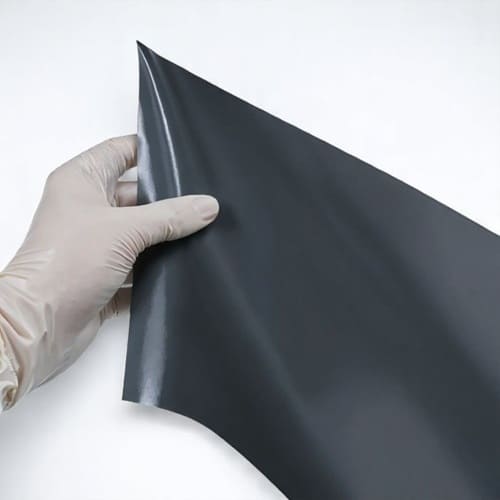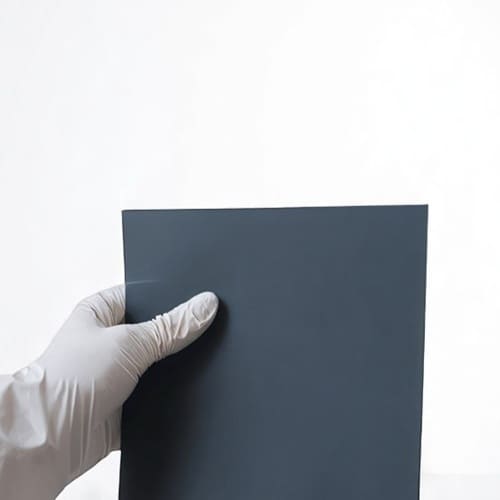Can Graphene Sheets Conduct Electricity Like Metals?
Graphene, a single layer of carbon atoms arranged in a two-dimensional honeycomb lattice, has captivated scientists and engineers since its discovery in 2004. This remarkable material is often heralded as a “wonder material” due to its extraordinary properties, including strength, flexibility, and electrical conductivity. In the realm of materials science, electrical conductivity is a critical property that determines a material’s suitability for applications in electronics, energy storage, and beyond. Metals like copper and silver have long been the gold standard for conductive materials, but graphene’s emergence raises an intriguing question: Can it conduct electricity as effectively as metals? In this article, we will explore the electrical conductivity of graphene and compare it to traditional metals, focusing on their similarities and differences.
At China Ceramic Manufacturer, we specialize in high-quality graphite material products with various forms and specifications, ensuring optimal performance for industrial and scientific applications.
What is the Graphene Sheet?
A graphene sheet is a single layer of carbon atoms arranged in a two-dimensional (2D) honeycomb lattice. It is the basic structural unit of graphite (used in pencils) but isolated as an ultra-thin, transparent, and highly conductive material.
Key Properties of Graphene Sheets:
- Atomic thickness: Just one atom thick (~0.34 nm), making it the world’s first 2D material.
- Exceptional strength: ~200x stronger than steel by weight.
- High electrical conductivity: Electrons move faster than in silicon or copper.
- Thermal conductor: Better than diamond or metals.
- Flexible & transparent: Potential for bendable electronics and displays.
Applications:
- Electronics (faster transistors, flexible circuits)
- Energy (batteries, supercapacitors)
- Sensors (biomedical, environmental)
- Composites (stronger, lighter materials)
Compared to Other Key Materials:
Graphene outperforms many conventional materials in strength, conductivity, and thermal properties. Below is a comparison with metals, silicon, and carbon nanotubes:
| Property | Graphene | Copper (Metal) | Silicon (Semiconductor) | Carbon Nanotubes (CNTs) |
| Thickness | 0.34 nm (monolayer) | Bulk material | Bulk material | 1D tube (1–2 nm diameter) |
| Tensile Strength | 130 GPa | 0.2 GPa | ~1 GPa | 50–150 GPa |
| Electrical Conductivity | ~10^6 S/cm | 5.9×10^5 S/cm | Depends on doping | 10^4–10^6 S/cm |
| Thermal Conductivity | ~5000 W/mK | 400 W/mK | 150 W/mK | 3000–6000 W/mK |
| Weight | Ultra-light | Heavy | Moderate | Lightweight |
| Flexibility | Highly flexible | Rigid | Brittle | Flexible |
Looking for top-quality graphite products? Explore China Ceramic Manufacturer’s selection.
How about the Electrical Conductivity of the Graphene Sheet?
How Graphene Conducts Electricity?
Graphene conducts electricity by allowing free-moving electrons to flow easily across its lattice. Unlike metals, where electrons are scattered by the atomic structure and impurities, the structure of graphene allows electrons to travel with minimal resistance. The lack of resistance in graphene is due to its honeycomb-like lattice structure, which provides an unobstructed path for electrons.
Key Conductivity Metrics
| Property | Graphene | Copper (for Comparison) |
| Electrical Conductivity | ~10⁶ S/cm (monolayer) | 5.9×10⁵ S/cm |
| Electron Mobility | 200,000 cm²/(V·s) (theoretical, pristine) | 30–50 cm²/(V·s) |
| Sheet Resistance | ~30 Ω/sq (ideal monolayer) | ~0.17 Ω/sq (bulk) |
| Current Density | ~10⁸ A/cm² (vs. 10⁶ A/cm² in Cu) | Limited by electromigration |
Why Is Graphene So Conductive?
Graphene’s 2D honeycomb lattice allows electrons to move like massless particles with minimal scattering, achieving electron mobilities up to 200,000 cm²/(V·s)—100x faster than silicon. Its zero bandgap and linear energy-momentum relationship enable near-ballistic transport, while its single-atom thickness eliminates out-of-plane resistance, making it ideal for high-speed electronics and transparent conductors.
- Zero bandgap: Electrons behave like massless particles (“Dirac fermions”), enabling near-ballistic transport.
- High electron mobility: Electrons move 100x faster than in silicon.
- 2D structure: No out-of-plane scattering, reducing resistance.
Comparison to Other Conductive Materials
| Material | Conductivity (S/cm) | Advantage Over Graphene |
| Graphene | 10⁶ | Highest mobility, flexible, transparent |
| Copper | 5.9×10⁵ | Cheaper, mature fabrication |
| Carbon Nanotubes | 10⁴–10⁶ | Tunable bandgap, but harder to align |
| Silver Nanowires | ~10⁶ | Better for stretchable electronics |
Exploring our optimized graphite products.
Comparison of the Graphene Sheet’s Electrical Conductivity with Metals
Electrical Conductivity of Metals
Metals like copper, silver, and gold are known for their excellent electrical conductivity. This is due to their atomic structure, where electrons are free to move in the outermost energy levels (known as the conduction band) of the atoms. However, the movement of these electrons can be impeded by defects, impurities, and temperature.
1. Conductivity Mechanism
- Free electrons: Valence electrons detach from atoms, forming a mobile cloud.
- Low resistance: Electrons scatter minimally (compared to semiconductors/insulators).
- Temperature dependence: Conductivity decreases with heating (due to increased phonon scattering).
2. Conductivity Rankings of Common Metals
| Metal | Conductivity (S/m at 20°C) | Resistivity (Ω·m) | Electron Mobility (cm²/(V·s)) |
| Silver | 6.30 × 10⁷ | 1.59 × 10⁻⁸ | 50–60 |
| Copper | 5.96 × 10⁷ | 1.68 × 10⁻⁸ | 30–50 |
| Gold | 4.52 × 10⁷ | 2.21 × 10⁻⁸ | 30–40 |
| Aluminum | 3.77 × 10⁷ | 2.65 × 10⁻⁸ | 10–15 |
| Iron | 1.00 × 10⁷ | 1.00 × 10⁻⁷ | ~5 |
Electrical Conductivity: Graphene Sheet vs. Metals
Graphene surpasses most metals in electron mobility and current-carrying capacity, though its bulk conductivity is comparable to copper. Here’s a direct comparison:
| Property | Graphene (Monolayer) | Copper (Metal) | Silver (Metal) |
| Electrical Conductivity | ~10⁶ S/cm (theoretical) | 5.9×10⁵ S/cm | 6.3×10⁵ S/cm |
| Electron Mobility | 200,000 cm²/(V·s) | 30–50 cm²/(V·s) | 50–60 cm²/(V·s) |
| Current Density | 10⁸ A/cm² (no breakdown) | ~10⁶ A/cm² (limited by electromigration) | Similar to Cu |
| Thickness | 0.34 nm (atomically thin) | Bulk material | Bulk material |
| Transparency | ~97.7% (visible light) | Opaque | Opaque |
Why Are Metals Less Conductive Than Graphene?
- Scattering: Electrons collide with lattice vibrations (phonons) and impurities.
- 3D bulk: Out-of-plane scattering occurs, unlike graphene’s 2D ballistic transport.
- Mobility: Metals have 10–100x lower electron mobility than graphene.
Key Differences between Graphene Sheet and Metals:
✅ Electron Speed:
- Graphene’s electrons move ballistically (like photons) with minimal scattering, enabling ultrafast electronics.
- Metals lose energy to phonon vibrations (resistive heating).
✅ Thickness Efficiency:
- A single graphene layer matches copper’s bulk conductivity per unit thickness (σ/t ≈ 10⁸ S/m² vs. Cu’s 10⁷ S/m²).
✅ Failure Mechanisms:
- Metals fail at high currents due to electromigration (atom displacement).
- Graphene handles 1,000x higher current densities without degradation.
Key Limitations of Metals
- Electromigration: High currents displace atoms (limits current density to ~10⁶ A/cm²).
- Oxidation: Surface corrosion (e.g., CuO) increases resistance.
- Weight/rigidity: Less suitable for flexible or lightweight applications.
Why Isn’t Graphene Replacing Metals Yet?
- No bandgap: Hard to “switch off” for transistors.
- Scalability: Pristine graphene is expensive to produce in large sheets.
- Contact resistance: Metal-graphene junctions lose efficiency.
When to Choose Metals Over Graphene?
- Cost: Copper is ~100x cheaper than CVD graphene.
- Maturity: Established manufacturing (wires, PCBs).
- Stability: Metals outperform graphene in high-temperature/oxidizing environments.
What Are the Factors Affecting the Conductivity of Graphene Sheets?
The electrical conductivity of graphene sheets is influenced by several intrinsic and extrinsic factors, which can either enhance or degrade its exceptional charge transport properties. Here’s a systematic breakdown:
1. Structural Perfection
✅ Defect Density:
- Pristine graphene (no defects): ~10⁶ S/cm
- With 0.1% vacancies: Drops to ~10⁴ S/cm
- Grain boundaries reduce mobility by 50-80%
✅ Crystalline Quality: CVD-grown graphene typically has lower conductivity than mechanically exfoliated flakes due to multidomain structures.
2. Substrate Interactions
✅ Supported vs. Suspended:
- Suspended graphene: 200,000 cm²/(V·s) mobility
- On SiO₂: ~10,000-40,000 cm²/(V·s) (charge impurity scattering)
- On hBN: Up to 100,000 cm²/(V·s) (atomically flat surface)
✅ Dielectric Environment: High-κ substrates can screen Coulomb scattering.
3. Doping Effects
✅ Chemical Doping:
| Dopant | Conductivity Change | Mechanism |
| HNO₃ (p-type) | +300% | Hole injection |
| AuCl₃ (n-type) | +400% | Electron donation |
| Oxygen | -90% | Disrupts sp² network |
✅ Gate Voltage: Allows dynamic tuning from hole to electron conduction.
4. Temperature Dependence
Unlike metals, graphene shows:
- At low T (<50K): Mobility ∝ T⁻¹ (impurity scattering dominates)
- At high T: Mobility ∝ T⁻¹.⁵ (phonon scattering dominates)
- Minimal resistivity ~30 Ω/sq at room temperature
5. Edge States
- Zigzag edges: Enhance edge conductivity
- Armchair edges: Semiconducting behavior
- Rough edges: Increase scattering
6. Layer Number
- Monolayer: Highest mobility (200,000 cm²/(V·s))
- Bilayer: ~50% reduction due to interlayer scattering
- Multilayer (>10L): Approaches graphite properties (~10³ S/cm)
7. Environmental Factors
- Air exposure: Adsorbed H₂O/O₂ causes p-doping (~10¹² cm⁻² carriers)
- Vacuum annealing: Restores intrinsic conductivity
- Encapsulation: Preserves properties (e.g., PMMA/hBN sandwich)
Request a custom quote for high-quality graphite products.
What Are the Applications of Graphene in Conductivity?
Graphene’s exceptional conductivity (∼10⁶ S/cm) and unique charge transport properties enable transformative applications across multiple industries.
1. Electronics & Optoelectronics
✅ High-Frequency Transistors
- RF devices reaching 427 GHz cutoff frequency (vs. 40 GHz for Si)
- THz operation for 6G communications
✅ Transparent Conductive Electrodes
- 97.7% optical transparency + 30 Ω/sq sheet resistance
- Replaces ITO in flexible displays (Samsung’s foldable OLED patents)
✅ Interconnects
- Current density tolerance: 10⁸ A/cm² (vs. 10⁶ A/cm² for Cu)
- 20% lower RC delay in 3nm node ICs
2. Energy Systems
✅ Battery Electrodes
- Li-ion anodes: 372 mAh/g theoretical capacity (10× graphite)
- Conductivity additive reduces impedance by 60% in NMC cathodes
✅ Supercapacitors
- 550 F/g specific capacitance (3× activated carbon)
- 10 ms charge/discharge cycles
✅ Fuel Cell Membranes
- Proton conductivity: 0.1 S/cm at 80°C (Nafion-equivalent)
- 50% lower methanol crossover
3. Advanced Composites
✅ Aerospace Structures
- 0.1 wt% loading increases composite conductivity to 10⁻² S/cm
- Lightning strike protection (dissipates 100 kA/m²)
✅ Smart Coatings
- 50 nm films provide EMI shielding (80 dB attenuation)
- Corrosion protection with 10¹² Ω·cm barrier resistance
4. Sensors & Biomedical
✅ Biosensors
- 10⁻¹² M dopamine detection limit
- 100 μs response time for neural interfaces
✅ Strain Sensors
- 500% stretchability with <5% conductivity loss
- GF >500 for structural health monitoring
5. Quantum Technologies
✅ Quantum Hall Resistance Standard
- Precision of 1 part in 10⁹ at 10 T magnetic fields
- Used in NIST’s graphene-based quantum standards
✅ Superconducting Hybrids
- Proximity-induced superconductivity at 1.6 K
- Majorana fermion platforms for topological qubits
At China Ceramic Manufacturer, we supply optimized-grade ceramic products that comply with ASTM and ISO standards, ensuring outstanding quality and reliability.
Challenges and Future Prospects
Despite its promise, graphene faces significant hurdles. Producing high-quality, defect-free graphene at scale remains a challenge. Current methods like chemical vapor deposition (CVD) are expensive and yield imperfect sheets, introducing defects that reduce conductivity. Additionally, integrating graphene into existing semiconductor manufacturing processes requires overcoming compatibility issues, as graphene lacks a natural bandgap, complicating its use in transistors.
However, ongoing research is addressing these challenges. Advances in synthesis techniques, such as roll-to-roll production, are improving scalability and reducing costs. Doping and functionalization strategies are being developed to tailor graphene’s properties, including introducing a bandgap for semiconductor applications. Looking ahead, graphene could revolutionize electronics, energy storage, and beyond, potentially complementing or replacing metals in specific niches.
✅ Current Challenges:
- Scalability: Producing large, defect-free sheets.
- Cost: High production expenses.
- Integration: Compatibility with existing technologies.
✅ Future Prospects:
- Improved synthesis methods (e.g., roll-to-roll CVD).
- Tailored properties via doping and functionalization.
- Potential to replace metals in flexible and transparent applications.
Graphene’s ability to conduct electricity is remarkable, rivaling and, in some cases, surpassing metals like copper and silver. Its unique electronic structure, characterized by Dirac cones and ballistic conduction, enables exceptional performance in a fraction of the weight and thickness of traditional conductors. While challenges like scalability and cost remain, graphene’s potential to transform electronics, energy storage, and nanotechnology is undeniable.
As research progresses, graphene may not fully replace metals but could complement them in applications where flexibility, transparency, and lightweight properties are paramount. The journey to unlock graphene’s full potential is ongoing, and continued investment in research and development is crucial. Scientists, engineers, and innovators are encouraged to explore graphene’s possibilities, paving the way for a future where this wonder material redefines conductivity.
For top-quality advanced graphite products, China Ceramic Manufacturer provides tailored solutions for various applications.
Looking for premium graphite materials? Contact us today!


